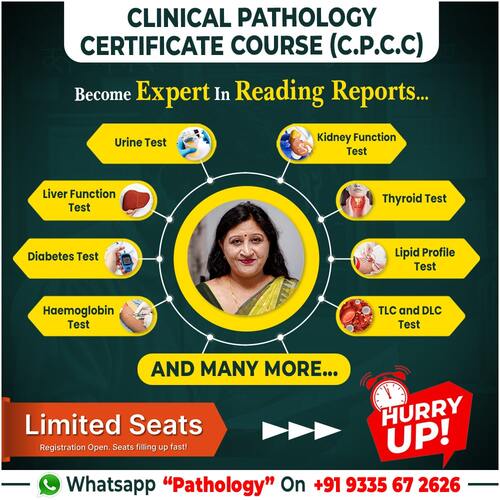Course Overview:
This online course provides a comprehensive understanding of various diagnostic tests used in clinical pathology. Therefore, you can learn how to read pathology reports by yourself. From urine and kidney function tests to lipid profiles and diabetes screenings, participants will gain insights into the significance, interpretation, and implications of these tests in diagnosing various health conditions.
Chapter 1: Introduction
Chapter 2: Urine Test
A. Physical Examination
- Volume
- Specific Gravity
- Appearance
- Colour
- Odour
- Deposit
- Foam
- Reaction (pH)
B. Chemical Examination
- Proteins
- Sugars
- Ketone Bodies
- Bilirubin and Bile Salts
- Nitrites
C. Microscopic Examination
- Casts
- Crystals
- Amorphous Substances
- Microorganisms
- Pus Cells
- Red Blood Cells (RBCs)
- Epithelial Cells
- Mucus
Chapter 3: Kidney Function Test
- Function of the Kidney
- Symptoms of Kidney Problems
- Serum Creatinine Test
- Blood Urea Nitrogen (BUN) Test
- Uric Acid
- Electrolytes
a) Sodium
b) Potassium
c) Chloride - Estimated Glomerular Filtration Rate (eGFR) Test
A. Stages of Chronic Kidney Disease- Stage 1
- Stage 2
- Stage 3
- Stage 4
- Stage 5
B. Acute Kidney Failure (Renal Failure)
Chapter 4: Liver Function Test
- Bilirubin (Indirect, Direct, and Total)
- Gamma Glutamyl Transferase Test
- SGPT/ALT Test
- SGOT/AST Test
- Total Protein Test
- Albumin Blood Test
- Globulin Blood Test
- Alkaline Phosphatase (ALP)
Chapter 5: Thyroid Test
- What are Thyroid Tests?
- Types of Thyroid Tests
- Test Details
- TSH Hormone: Significance and Function
- What is the TSH Test?
- Why do I Need a TSH Test?
- High T3 and T4 Levels: Causes and Effects
- Low T3 and T4 Levels: Causes and Effects
Chapter 6: Lipid Profile Test
- What is a Lipid Panel?
- Five Tests in a Lipid Panel
- Why do I Need a Lipid Panel Blood Test?
- Normal Lipid Panel Results
- Purpose of the Cholesterol Total Test
- Signs and Symptoms of High Cholesterol Levels
Chapter 7: Hemoglobin Test
- What is Hemoglobin?
- Symptoms of Low Hemoglobin
- Causes of Low Hemoglobin Levels
- Symptoms of High Hemoglobin
- Causes of High Hemoglobin Levels
Chapter 8: Diabetes Test
Part A
- Four Common Types of Diabetes Tests
A. HbA1C Test
B. Fasting Blood Sugar Test
C. Random Blood Sugar Test
D. Glucose Tolerance Test - Symptoms of High Blood Sugar
- Symptoms of Low Blood Sugar
- Types of Diabetes
- Other Causes of High Glucose Levels
- Meaning of Low Blood Glucose Levels
Part B
- HbA1C Test (Glycated Hemoglobin Test) Overview
- What is Glycated Hemoglobin (HbA1C)?
- Why the A1C Test Reflects Average Glucose Levels Over Three Months
- Who Should Take the HbA1C Test?
Chapter 9: TLC and DLC Test
Part A
- What are Leukocytes (WBC)?
- Two Methods for Counting Leukocytes
- Total Leukocyte Count (TLC)
- Purpose of a Total Leukocyte Count Test
- Causes of High and Low TLC
- Factors Leading to Leukocytosis
- Symptoms of Leukocytosis
- Factors Leading to Leukopenia
- Symptoms of Leukopenia
Part B
- Differential Leukocyte Count (DLC)
- Types of Leukocytes
a) Granulocytes
b) Agranulocytes - Neutrophils
- Eosinophils
- Basophils
- Lymphocytes
a) Small Lymphocytes
b) Large Lymphocytes - Monocytes
- Normal Values of Leukocytes
- What Happens When DLC is High?
Chapter 10: Conclusion and End of Course Guidance
Course Fee includes Certificate Fee, Exam Fee, Lifetime Access Fee, and Taxes.
(No Hidden Cost)
For any help, fill out this form to get a call back (CLICK HERE)
Please note: This online course requires internet connectivity for accessing the course content. It’s important to note that the course fee is non-refundable once purchased. The course is conducted in Hindi language, and although English subtitles are currently unavailable, they are in the process of being added and will soon be accessible. The primary course material consists of video content, and it’s essential to be aware that additional resources like books are not part of the course package.



